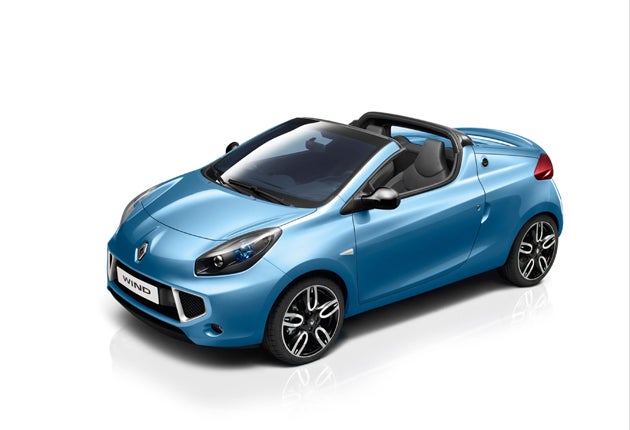Renault Wind
Renault's new coupé-cabriolet is a little gem that thinks it's a sports car

Your support helps us to tell the story
From reproductive rights to climate change to Big Tech, The Independent is on the ground when the story is developing. Whether it's investigating the financials of Elon Musk's pro-Trump PAC or producing our latest documentary, 'The A Word', which shines a light on the American women fighting for reproductive rights, we know how important it is to parse out the facts from the messaging.
At such a critical moment in US history, we need reporters on the ground. Your donation allows us to keep sending journalists to speak to both sides of the story.
The Independent is trusted by Americans across the entire political spectrum. And unlike many other quality news outlets, we choose not to lock Americans out of our reporting and analysis with paywalls. We believe quality journalism should be available to everyone, paid for by those who can afford it.
Your support makes all the difference.As I write, some much-needed rain is falling.
The past few days, by contrast, have been brilliantly sunny. And my point is? That the car you see here can match meteorological moods with a deftness you are unlikely to encounter in any other car of its size and intent.
Well, that's given the game away. But stay with me, because the Renault Wind is a clever and interesting little car on many levels. It's a coupé-cabriolet based on a small hatchback, in this case the Renault Twingo (and that car's under-the-skin progenitor, the previous-generation Clio), but the interpretation is rather more adventurous than is usual.
There is no attempt at a rear seat, for example. That means the roof can be short, which in turn makes it easier to stow. And that means the Wind doesn't suffer the fat-bottomed, saggy look that is the aesthetic ruin of many a solid-roofed convertible.
So the rump is short and pert. And any residual visual bulk dictated by roof stowage is cleverly made into a styling feature, specifically a pair of buttresses tapering rearwards and downwards from the back of the cabin. Then there's the roof itself, a construction of eureka-moment cleverness.
It's a one-piece panel in lightweight black plastic and glass, which hinges at the base of its rear pillars so it can do a complete backflip over the boot space before the rear cover closes over it. The entire process takes just 12 seconds, and the ample boot space is unaffected by the roof's position. Compared with most coupé-cabriolets, which are left with a minimal boot and awkward luggage access with the roof stowed, this is a revelation. And the whole roof construction, complete with motors and cover, weighs just 21.8kg.
Renault can't claim a world first for this ingenious roof design, though. Devised and engineered by Webasto, it first appeared on Ferrari's 575 Superamerica. Glamorous as this Ferrari roadster was, the lack of a permanent roof did terrible things to its structural integrity. Over bumps it was possibly the wobbliest convertible I have ever driven. There's no such problem with the Wind. On the contrary, with its roof open it has a tautness rare in an open-top car this side of a purpose-designed sports car. A big road ripple occasionally brings on a slight shudder from the windscreen frame, and the steering loses some of its focus just either side of the straight-ahead position, but otherwise the Wind is as crisp, alert and rattle-free roof-down as it is roof-up.
So much so, in fact, that at times you really could almost be driving a sports car. That is largely because the Wind was developed by Renaultsport, usually responsible for highly enjoyable, warmed-up versions of Renault's hatchbacks. So under its cute, fun-car styling lies much of what made the old Clio Renaultsport 182 such a joy. That car's eager grip, its terrier-like ability to scuttle through twists and turns, and its ability to mop up difficult road surfaces are all here.
Two things aren't, though. One is the steering. It is nicely weighted and mostly accurate enough, but there's no real feel of the road and the Wind's grip of it. That's because it is an electrically powered system, which is good for energy-saving but bad for tactile communication. The other is the way the Wind goes.
Two engines are offered, a 1.2-litre TCe unit with a turbocharger and 100bhp, and a non-turbo 1.6 with 133bhp. You would expect the latter to be livelier, and so it is if you work it hard and keep it spinning quickly. Your reward is a deep, crisp engine note, but attempts to power with panache out of a tight, uphill corner are met with disinterest. The strong low-speed pull of the TCe engine makes it a better companion for such roads, as well as a more economical one.
With either engine you'll have plenty of open-top fun. Roof-up, the Wind becomes a cosy coupé; either way, you are ensconced in a cabin rich in hard plastics but with dashboard styling well matched to the exterior's concept-car aura.
A sports car the Wind is not. But as a practical, entertaining, good-value small car – the range is from £15,500 to £18,200 – with an open top, it's a little gem.
The Rivals
Mazda MX-5 1.8 SE Roadster Coupé: £18,870.
A proper sports car with a folding metal roof. Entry-level 1.8 has smooth, sweet engine. Rear-wheel drive gives very pleasing handling.
Mini Cooper Convertible: From £16,415.
Fabric roof, room for children in the back, tiny boot. Mini charm but weight blunts pace. Poor view aft with roof up.
Peugeot 207 CC 1.6 VTi: From £17,095.
Conventional coupé-cabriolet with heavy roof, marginal rear space, compromised boot access and bulky looks. Surprisingly good to drive.
Join our commenting forum
Join thought-provoking conversations, follow other Independent readers and see their replies
Comments